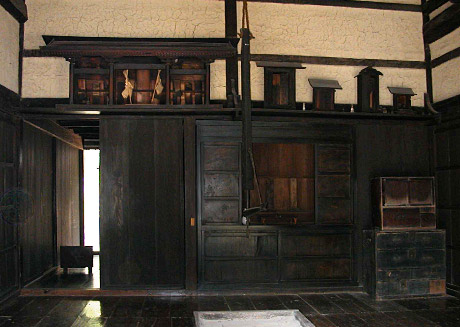An interior shelf *tana 棚, where paper talismans, kamifuda 神札, or amulets, gofu 御符, issued by the major Shinto shrines were enshrined for worship as tutelary household deities *kami 神, in traditional vernacular houses *minka 民家 of the Edo period. Candles were lit and offerings of rice, fruit, fish, rice wine etc. were made daily. Little is known about the early development of the kamidana, but small shrines to tutelary deities inside a residence go back to ancient times among the aristocracy, as the Heian period Higashi Sanjou 東三条 mansion demonstrates. It is probable that in early times offering tables within a house were not permanent, but were set up as occasion demanded for specific ceremonies and afterwards removed. Dating the emergence of the kamidana is difficult because there are few old examples, but it was closely connected with the development of the domestic Buddhist altars *butsudan 仏壇. One of the earliest surviving examples may be found at Yoshimura 吉村 House, a 17c village headman's residence near Osaka, now an Important Cultural Property. This consists of a recess equipped with shelves and sliding doors *fusuma 襖, but it is not clear whether this originally functioned as a kamidana. A more common type of kamidana occupied the top part of a cupboard unit todana 戸棚, and resembles a doored upper shelf *fukurodana 袋棚. However, the most widespread type was a plain board forming a shelf fixed to the top of the lintel members *kamoi 鴨居, and supported by cantilevered brackets from beneath, or stabilized with timber hangers *tsurigi 釣木, suspended from the beams above. On this shelf a miniature Shinto shrine was often installed to contain the kamifuda. This structure may be elaborate in design, though unlike the miniature shrine cabinet *zushi 厨子, of the Buddhist altar, the timber was usually unlacquered *shiraki 白木, following one of the most venerable traditions of shrine architecture. This type of kamidana was believed to have developed comparatively late and the decorative shrine later still. The kamifuda enshrined may be that of a clan deity, ujigami 氏神, or come from one of the major national shrines, such as Ise Jinguu 伊勢神宮. Particularly in the houses of craftsmen and merchants, there may be separate shelves known as engidana 縁起棚, where deities with combined Shinto and Buddhist identities, such as *Ebisu 恵比須, *Koujin 荒神 or Inari 稲荷 were commonly enshrined. It was not unusual for houses to have two separate kamidana. Kamidana were most often located in one of the main everyday living rooms or the kitchen, close to the earth-floored area *doma 土間. They were sometimes placed toward the rear of the room, facing the front of the house *omote 表, or at the high end *kamite 上手, facing down the room toward the doma. They were often placed in the corner of a room for better support. In many 17c to early 18c farmhouses in central and eastern Japan, the kamidana, though usually a later addition, was placed close to the shallow decorative alcove *oshi-ita 押板, in the living room *hiroma 広間. In rare cases, for instance, if the house was totally Shinto and had no butsudan, the kamidana was installed in one of the formal reception rooms *zashiki 座敷.
|



